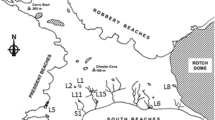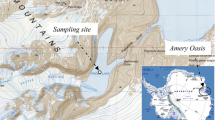Abstract
The prokaryotic abundance and diversity in three cold, oligotrophic Patagonian lakes (Témpanos, Las Torres and Mercedes) in the northern region Aysén (Chile) were compared in winter and summer using 16S rRNA fluorescence in situ hybridization and PCR-denaturing gradient gel electrophoresis technique. Prokaryotic abundances, numerically dominated by Bacteria, were quite similar in the three lakes, but higher in sediments than in waters, and they were also higher in summer than in winter. The relative contribution of Archaea was greater in waters than in sediments, and in winter rather than in summer. Despite the phylogenetic analysis indicated that most sequences were affiliated to a few taxonomic groups, mainly referred to Proteobacteria (consisting of Beta-, Alpha- and Gammaproteobacteria) and Euryarchaeota (mainly related to uncultured methanogens), their relative abundances differed in each sample, resulting in different bacterial and archaeal assemblages. In winter, the abundance of the dominant bacterial phylotypes were mainly regulated by the increasing levels of total organic carbon in waters. Archaeal abundance and richness appeared mostly influenced by pH in winter and total nitrogen content in summer. The prokaryotic community composition at Témpanos lake, located most northerly and closer to a glacier, greatly differed in respect to the other two lakes. In this lake was detected the highest bacterial diversity, being Betaproteobacteria the most abundant group, whereas Alphaproteobacteria were distinctive of Mercedes. Archaeal community associated with sediments was mainly represent by members related to the order of Methanosarcinales at Mercedes and Las Torres lakes, and by Crenarchaeota at Témpanos lake. Our results indicate that the proximity to the glacier and the seasonality shape the composition of the prokaryotic communities in these remote lakes. These results may be used as baseline information to follow the microbial community responses to potential global changes and to anthropogenic impacts.






Similar content being viewed by others
References
APHA-AWWA-WPCF (1985) Standard methods for the examination of water and wastewater, 16th edn. EUA, Washington
Aguayo J, Barra R, Becerra J, Martínez M (2009) Degradation of 2, 4, 6 tribromophenol and 2, 4, 6 trichlorophenol by aerobic heterotrophic bacteria present in psychrophilic lakes. World J Microbiol Biotechnol 25:553–560
Aguayo P, González C, Barra R, Becerra J, Martínez M (2014) Herbicides induce change in metabolic and genetic diversity of bacterial community from a cold oligotrophic lake. World J Microbiol Biotechnol 30:1101–1110
Amann RI, Ludwig W, Schleifer KH (1995) Phylogenetic identification and in situ detection of individual microbial cells without cultivation. Microbiol Rev 59:143–169
Auguet JC, Nomokonova N, Camarero L, Casamayor EO (2011) Seasonal changes of freshwater ammonia oxidizing archaeal assemblages and nitrogen species in oligotrophic alpine lakes. Appl Environ Microbiol 77:1937–1945
Barra R, Cisternas M, Urrutia R, Pozo K, Pacheco P, Parra O, Focardi S (2001) First report on chlorinated pesticide deposition in a sediment core from a small lake in central Chile. Chemosphere 45:749–757
Besoain EM, Ruiz RS, Hepp CK (1995) The Hudson volcano eruption and its effects on the agriculture of the XI Región. Agricultura Técnica (Chile) 55:204–219
Bertrand S, Boës X, Castiaux J, Charlet F, Urrutia R, Espinoza C, Charlier B, Lepoint G, Fagel N (2005) Temporal evolution of sediment supply in Lago Puyehue (Southern Chile) during the last 600 years and its climatic significance. Quarter Res 64:163–175
Bogard MJ, del Giorgio PA, Boutet L, Garcia-Chaves MC, Prairie YT, Merante A, Derry AM (2014) Oxic water column methanogenesis as a major component of aquatic CH4 fluxes. Nat Commun 5:5350. doi:10.1038/ncomms6350
Borrel G, Jézéquel D, Biderre-Petit C, Morel-Desrosiers N, Morel JP, Peyret P, Fonty G, Lehours AC (2011) Production and consumption of methane in freshwater lake ecosystems. Res Microbiol 162:832–847
Boyle J (2002) Mineralogical and geochemical indicator techniques. In: Last W, Smol JP (eds) Tracking environmental change using lake sediments. Springer, New York, pp 83–141
Campos H (1984) Limnological studies of Araucanian lakes, Chile. Verhandlungen der Internationale Vereinigung für Theoretische und Angewandte Limnologie 22:1319–1327
Casamayor EO, Schäfer H, Baňeras L, Pedrós-Alió C, Muyzer G (2000) Identification of and spatio-temporal differences between microbial assemblages from two neighboring sulphur lakes: comparison by microscopy and denaturing gradient gel electrophoresis. Appl Environ Microbiol 66:499–508
Cavicchioli R (2006) Cold-adapted Archaea. Nat Rev Microbiol 4:331–343
Cavicchioli R, Ostrowski M, Fegatela F, Goodchild A, Boixereus G (2003) Life under nutrient limitation in oligotrophic marine environments: an eco/physiological perspective of Sphingopyxis alaskiensis (formerly Sphingomonas alaskiensis). Microb Ecol 45:203–217
Chan OC, Claus P, Casper P, Ulrich A, Lueders T, Conrad R (2005) Vertical distribution of structure and function of the methanogenic archaeal community in Lake Dagow sediment. Environ Microbiol 7:1139–1149
Curtis TP, Sloan WT (2004) Prokaryotic diversity and its limits: microbial community structure in nature and implications for microbial ecology. Curr Opin Microbiol 7:221–226
Ferrari VC, Hollibaugh JT (1999) Distribution of microbial assemblages in the central Arctic Ocean basin studied by PCR/DGGE: analysis of a large data set. Hydrobiologia 401:55–68
Franzmann PD (1996) Examination of Antarctic prokaryotic diversity through molecular comparisons. Biodivers Conserv 5:1295–1305
Gammons CH, Wood SA, Pedrozo F, Varekamp JC, Nelson BJ, Shope CL, Baffico G (2005) Hydrogeochemistry and rare earth element behavior in a volcanically acidified watershed in Patagonia, Argentina. Chem Geol 222:249–267
Godoy F, Vancanney M, Martinez M, Steinbüchel A, Swings J, Rehm A (2003) Sphingopyxis chilensis sp. a chlorophenol-degrading bacterium which accumulates polyhydroalkanoates, and transfer of Sphingomonas alaskensis to Sphingopyxis alaskensis comb. nov. Int J Syst Evol Microbiol 53:473–477
Gugliandolo C, Michaud L, Lo Giudice A, Lentini V, Rochera C, Camacho A, Maugeri TL (2016) Prokaryotic community in lacustrine sediments of Byers Peninsula (Livingston Island, Maritime Antarctica). Microb Ecol 71:387–400
Haugland RP (2002) LIVE/DEAD BacLight bacterial viability kits. In: Gregory J (ed) Handbook of fluorescent probes and research products, ninth edition. Molecular Probes, Eugene, pp 626–628
Hiorns WD, Methe BA, Nierzwicki-Bauer SA, Zehr JP (1997) Bacterial diversity in Adirondack mountain lakes as revealed by 16S rRNA gene sequences. Appl Environ Microbiol 63:2957–2960
Jiang H, Dong H, Zhang G, Yu B, Chapman L, Matthew F (2006) Microbial diversity in water and sediment of Lake Chaka, an athalassohaline lake in Nortwestern China. Appl Environ Microbiol 72:3832–3845
Kallmeyer J, Smith DC, Spivack AJ, D’Hondt S (2008) New cell extraction procedure applied to deep subsurface sediments. Limnol Oceanogr Methods 6:236–245
Kendall MM, Boone DR (2006) The order Methanosarcinales. In: Dworkin M, Falkow S, Rosenberg E, Schleifer KH, Stackebrandt E (eds) The prokaryotes 3rd edn, vol 3, Springer, New York, pp 244–256
Koizumi Y, Takii S, Fukui M (2004) Depth-related change in archaeal community structure in a freshwater lake sediment as determined with denaturing gradient gel electrophoresis of amplified 16S rRNA genes and reversely transcribed rRNA fragments. FEMS Microbiol Ecol 48:285–292
Liu FH, Lin GH, Gao G, Qin BQ, Zhang JS, Zhao GP, Zhou ZH, Shen JH (2009) Bacterial and archaeal assemblages in sediments of a large shallow freshwater lake, Lake Taihu, as revealed by denaturing gradient gel electrophoresis. J Appl Microbiol 106:1022–1032
Loveland-Curtze J, Miteva VI, Brenchley JE (2009) Herminiimonas glaciei sp. nov., a novel ultramicrobacterium from 3042 m deep Greenland glacial ice. Int J Syst Evol Microbiol 59:1272–1277
Mackenzie R, Barros J, Martínez M (2011) Metabolic and molecular analysis of aerobic heterotrophic bacteria in cold-oligotrophic freshwater ecosystems. World J Microbiol Biotechnol 27:2499–2504
Miteva VI, Sheridan PP, Brenchley JE (2004) Phylogenetic and physiological diversity of microorganisms isolated from a deep greenland glacier ice core. Appl Environ Microbiol 70:202–213
Muyzer G, de Waal EC, Uitterlinden AG (1993) Profiling of complex microbial populations by denaturing gradient gel electrophoresis analysis of polymerase chain reaction-amplified genes coding for 16S rRNA. Appl Environ Microbiol 59:695–700
Nayak DD, Marx CJ (2014) Genetic and phenotypic comparison of facultative methylotrophy between Methylobacterium extorquens strains PA1 and AM1. PLoS ONE 9:e107887
Nocker A, Burr M, Camper AK (2007) Genotypic microbial community profiling: a critical technical review. Microb Ecol 54:276–289
Newton RJ, Jones SE, Eiler A, McMahon KD, Bertilsson S (2011) A guide to the natural history of freshwater lake. Microbiol Mol Biol Rev 75:14–49
Pearce DA (2003) Bacterioplankton community structure in a Maritime Antarctic oligotrophic lake during a period of holomixis, as determined by DGGE and FISH. Microb Ecol 46:92–105
Pearce DA, Galand PE (2008) Microbial biodiversity and biogeography. In: Vincent W, Laybourn-Parry J (eds) Polar lakes and rivers, limnology of Arctic and Antarctic aquatic ecosystems. Oxford University Press, New York, pp 213–230
Pernthaler J, Glöckner FO, Schönhuber W, Amann R (2001) Fluorescence in situ hybridization with rRNA-targeted oligonucleotide probes. Methods Microbiol 30:207–226
Price B, Sowers T (2004) Temperature dependence of metabolic rates for microbial growth, maintenance, and survival. PNAS 10:4631–4636
Priscu J, Christner B (2003) Earth’s icy biosphere. In: Bull AT (ed) Microbial diversity and bioprospecting. ASM press, Washington, pp 130–145
Raskin L, Stromley JM, Rittmann BE, Stahl DA (1994) Group specific 16S rRNA hybridization probes to describe natural communities of methanogens. Appl Environ Microbiol 60:1232–1240
Schäfer H, Muyzer G (2001) Denaturing gradient gel electrophoresis in marine microbial ecology. Methods Microbiol 30:425–468
Schiaffino MR, Sánchez ML, Gerea M, Unrein F, Balagué V, Gasol JM, Izaguirre I (2016) Distribution patterns of the abundance of major bacterial and archaeal groups in Patagonian lakes. J Plankton Res 38:64–82
Schumacher BA (2002) Methods for the determination of total organic carbon (TOC) in soils and sediments. Ecological risk assessment support center office of research and development US. Environmental Protection Agency, Washington DC, pp 1–25
Schwarz JIK, Eckert W, Conrad R (2007) Community structure of Archaea and Bacteria in a profundal lake sediment Lake Kinneret (Israel). Syst Appl Microbiol 30:239–254
Soto D (2002) Oligotrophic patterns in southern Chilean lakes: the relevance of nutrients and mixing depth. Rev Chil Hist Nat 75:377–393
Steven B, Briggs G, McKay CP, Pollard WH, Greer CW, Whyte LG (2007) Characterization of the microbial diversity in a permafrost sample from the Canadian high Arctic using culture-dependent and culture-independent methods. FEMS Microbiol Ecol 59:513–523
Tindall BJ, Brambilla E, Steffen M, Neumann R, Pukall R, Kroppenstedt RM, Stackebrandt E (2000) Cultivatable microbial biodiversity: gnawing at the Gordian knot. Environ Microbiol 72:310–318
Woelfl S, Villalobos L, Parra O (2003) Trophic parameters and method validation in Lake Riñihue (North Patagonia: Chile). Rev Chil Hist Nat 76:459–474
Wilhartitz IC, Mach RL, Teira E, Reinthaler T, Herndl GJ, Farnleitner AH (2007) Prokaryotic community analysis with CARD-FISH in comparison to FISH in ultra-oligotrophic ground- and drinking water. J Appl Microbiol 103:871–881
Ye WJ, Liu XL, Lin SQ, Tan J, Pan JL, Li DT (2009) The vertical distribution of bacterial and archaeal communities in the water and sediment of Lake Taihu. FEMS Microbiol Ecol 70:263–276
Zwart G, Crump BC, Agterveld MP, Hagen F, Han SK (2002) Typical freshwater bacteria: an analysis of available 16S rRNA gene sequences from plankton of lakes and rivers. Aquat Microb Ecol 28:141–155
Acknowledgements
This work was supported by grants Fondecyt no 1100462 and Enlace VRID no 214.036.041-1.0.
Author information
Authors and Affiliations
Corresponding author
Ethics declarations
Conflict of interest
None.
Ethical approval
This article does not contain any studies with human or animal subjects.
Rights and permissions
About this article
Cite this article
Aguayo, P., González, P., Campos, V. et al. Comparison of Prokaryotic Diversity in Cold, Oligotrophic Remote Lakes of Chilean Patagonia. Curr Microbiol 74, 598–613 (2017). https://doi.org/10.1007/s00284-017-1209-y
Received:
Accepted:
Published:
Issue Date:
DOI: https://doi.org/10.1007/s00284-017-1209-y




